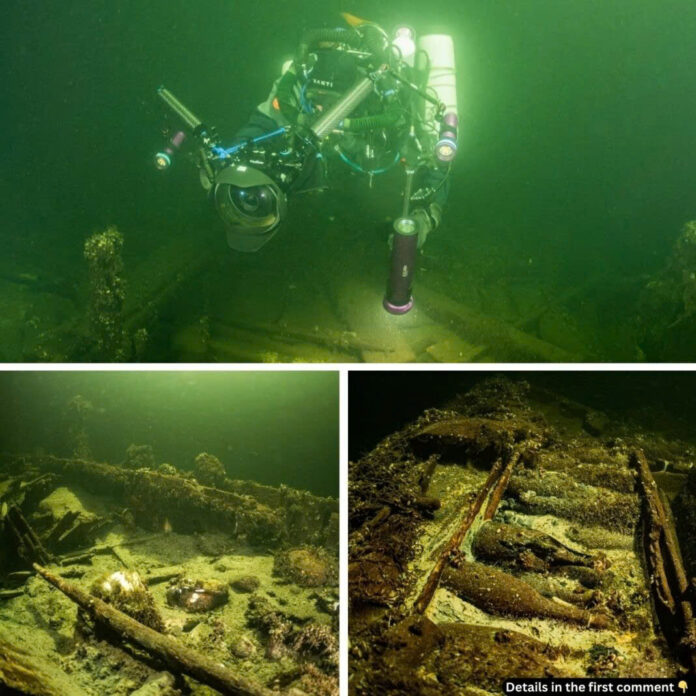In the mysterious depths of the Baltic Sea, marine archaeologists have made an extraordinary discovery that’s rewriting our understanding of 19th-century maritime luxury trade. A perfectly preserved shipwreck, resting peacefully for over 170 years, has emerged from the ocean floor carrying an astonishing cargo of untouched champagne bottles and premium mineral water.
The Remarkable Find Beneath Swedish Waters
Location and Initial Discovery
Twenty nautical miles south of Sweden’s historic Öland island, the Baltictech diving expedition made what would become one of the most significant underwater archaeological discoveries in recent years. Led by veteran diver Tomasz Stachura, the team initially set out on a routine exploration mission but quickly realized they had stumbled upon something extraordinary.

The vessel, dating back to the mid-1800s, lay in remarkably pristine condition on the seabed. What caught the divers’ immediate attention wasn’t just the ship’s excellent preservation, but the incredible abundance of its cargo—wooden crates packed to capacity with luxury goods that told a fascinating story of European high society.
An Underwater Treasure Vault
The ship’s hold revealed approximately 100 bottles of champagne, each one sealed and untouched by time. These weren’t ordinary bottles—they represented the pinnacle of 19th-century luxury, originally destined for Europe’s most affluent circles where champagne was considered the ultimate symbol of celebration and status.

Equally fascinating were the numerous bottles of Selters mineral water, each bearing authentic clay seals and distinctive German branding. This wasn’t just any mineral water—Selters was the premium choice of royalty and aristocrats, prized for its supposed healing properties and exclusive reputation. The brand markings helped researchers establish the cargo’s timeline, placing it between 1850 and 1867.
Archaeological Excellence in Extreme Conditions
Documentation and Preservation Techniques
Working in the challenging underwater environment of the Baltic Sea, the diving team employed sophisticated documentation methods to catalog their findings. Every artifact was carefully photographed and recorded before any disturbance occurred, ensuring that the historical context remained intact.

The exceptional preservation of both the vessel and its contents can be attributed to the Baltic Sea’s unique characteristics—its cold temperatures and low oxygen levels create an almost perfect natural preservation chamber. This environment has protected the wooden ship structure and its delicate cargo from the decay that typically affects underwater archaeological sites.
Professional Collaboration and Research

The discovery has brought together an impressive coalition of experts, including the Dutch marine research company MARIS, scholars from Södertörn University, and Swedish underwater archaeology specialists. This collaborative approach ensures that the site receives the comprehensive study it deserves while maintaining the highest standards of archaeological practice.
Historical Significance and Cultural Context
Trade Routes and Luxury Commerce
This shipwreck offers invaluable insights into the sophisticated trade networks of 19th-century Europe. The Baltic Sea served as a crucial commercial highway, connecting major trading centers and facilitating the movement of luxury goods across the continent. Ships like this one were the lifelines of an exclusive market that catered to the wealthy elite.
The presence of Selters mineral water is particularly significant—this premium product from Hesse, Germany, was so valuable that it often traveled under armed guard. Its discovery alongside fine champagne and porcelain illustrates the interconnected nature of Europe’s luxury trade networks and the high demand for prestigious goods.
Maritime Heritage and Archaeological Value

The wreck’s location near Öland island highlights the strategic importance of this area in historical maritime routes. The island served as a crucial navigation point for vessels traversing the Baltic Sea, making it a natural location for such discoveries.
This find contributes significantly to our understanding of 19th-century shipbuilding techniques, cargo handling methods, and the social dynamics of luxury consumption during this pivotal period in European history.
Video
Future Research and Conservation Plans
Careful Extraction Planning
Despite the excitement surrounding the discovery, the research team is taking a measured approach to the next phase of exploration. As Stachura wisely noted, after resting undisturbed for 170 years, the wreck can wait another year while proper extraction protocols are developed.

The team is currently working with administrative authorities to establish comprehensive guidelines that will ensure the safe recovery of artifacts without compromising their historical integrity. Advanced technology, including remotely operated vehicles and specialized lifting equipment, will likely play crucial roles in the extraction process.
Scientific Analysis and Research Opportunities
Future research plans include detailed chemical analysis of the champagne and mineral water, which could reveal fascinating insights into 19th-century production methods and quality standards. The porcelain and other artifacts may provide additional clues about the ship’s origin, intended destination, and the broader context of its final voyage.

These investigations will not only enhance our knowledge of this specific discovery but also contribute valuable data to the growing field of maritime archaeology, potentially inspiring similar explorations throughout the Baltic region.
A Window into the Past
This remarkable discovery represents more than just an archaeological find—it’s a direct connection to the luxury, craftsmanship, and commercial sophistication of 19th-century European society. The pristine champagne bottles and premium mineral water serve as tangible links to a world where such items represented the height of refinement and exclusivity.

As researchers continue their work, this Baltic Sea shipwreck promises to yield new understanding about historical trade practices, maritime technology, and the cultural values that shaped an era. It stands as a testament to the ocean’s power to preserve our shared heritage and the dedication of modern archaeologists to uncover and protect these precious glimpses into our collective past

